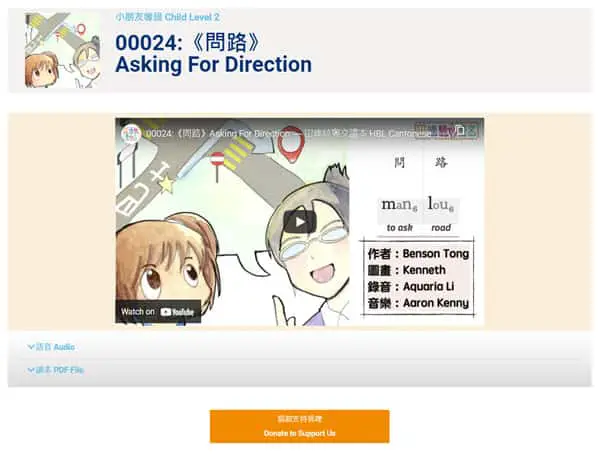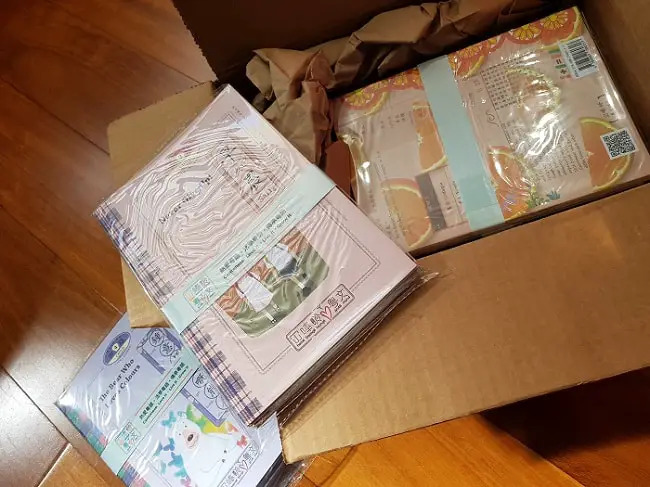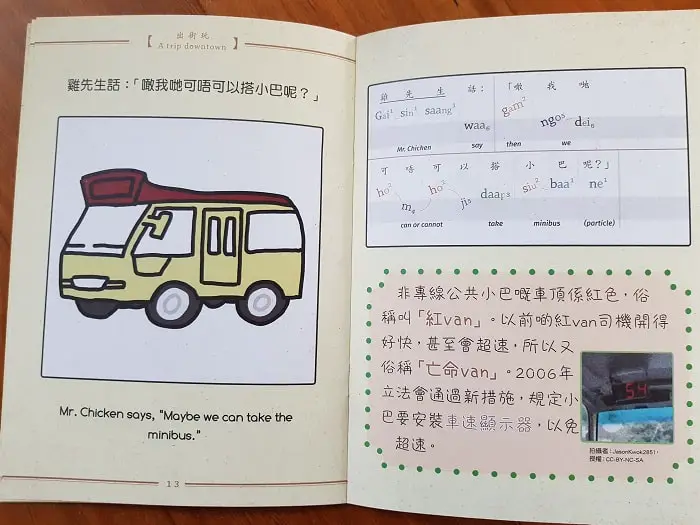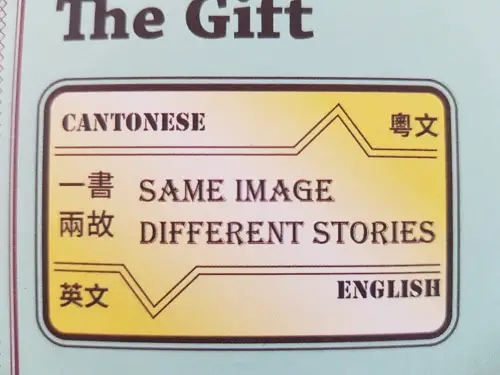(Please note that this is not a paid post, I am not affiliated with Hambaanglaang, that this review is based on my personal opinion, I did not request or receive any books in exchange for a review. I purchased all forty books at full price).
Are you looking for resources which are…
- written in Colloquial Cantonese and not Standard Chinese
- with Jyutping
- with English translation
- available in print and with audio
- suitable for kids (and adults) who are learning Cantonese
- are good value for money
冚唪唥粵文讀本 Hambaanglaang Cantonese Graded Readers are your answer!
In the pursuit of more Cantonese books
Readers of this blog probably know this – I am a huge fan of Colloquial Cantonese print materials and resources. I use them to improve my Cantonese, and am also using to teach my kid to speak Cantonese. I have been amassing a collection of Cantonese books and other Cantonese resources, and constantly looking for more. I have also been transcribing and translating books and readers, mostly for personal use, but this is a very labour-intensive and time-consuming task, and I have not done as many as I would have liked.
So, when 冚唪唥粵文 Hambaanglaang Cantonese released their print edition of their stories, I bought all 40 of them and waited eagerly for my parcel from Hong Kong. I am really soooooo excited by this, and I strongly believe these books will make a huge difference in addressing the lack of Cantonese stories, especially for children, and that these books will go a long way in helping more children (and adults) learn Cantonese. Join me and build your Cantonese library!
Unboxing my parcel
I ordered all eight available sets. Each set has five books. That means that I now have 40 more new Colloquial Cantonese books!
Here are my unboxing pictures. Not sure how other orders are packaged, but just want to share mine. (Personal details have been blurred out)
So happy with my new books!!
So, what exactly is 冚唪唥粵文 Hambaanglaang Cantonese?
They are a collection of Cantonese resources created by volunteers, for Cantonese learners. They include Cantonese stories, or graded readers.
I first encountered 冚唪唥 Hambaanglaang through their YouTube channel in June 2020 when they launched with a few stories read in Cantonese, with Colloquial Cantonese characters, with Jyutping presented graphically. At that point of time, the books were not available in print.
A year on, there are now over 100 stories on YouTube and SoundCloud, and they have just published 40 graded readers and launched them at the Hong Kong Book Fair.
More about these wonderful readers
I love these readers! And I really do believe that they make a difference for those who are learning/ teaching Cantonese.
Firstly, they do have all that I need in terms of Cantonese resources:
- They are written in Colloquial Cantonese and not Standard Chinese. This is great, as I can read the words straight away, without having to translate in my head. This is awesome for everyone, but even more so for those who cannot read Standard Chinese well or at all, as they now can read these books to their kids and to themselves. Even though I can read Chinese, this has helped me soooo much.

- There is romanisation for the characters to help pronunciation. Hambaanglang uses Jyutping, and takes it one step further. They include a graphical representation of the tones. After all, how many people remember what each tone number corresponds to – is it rising, falling, etc etc etc?

- There are phrase by phrase Cantonese- English translations – and this is important for Cantonese learners, as it shows how the sentence is broken down into phrases, and you can also see more clearly the Cantonese syntax. (see above pix)
- There is audio on Soundcloud and video on YouTube, so that you can listen to it being read. Audio can be downloaded or streamed online.
- Written by native Cantonese speakers – this sounds like common sense, but you would be surprised by how many resources are created by non-native speakers. Even though I feel I am relatively fluent, I much prefer to read a book written by someone more fluent than I am. For example, even as a heritage speaker, I am conscious that sometimes when I write or translate text, I need to add in the final particles 尾音 (mei2 jam1) such as 呀(aa3), 㗎(gaa3), 啦(laa3), 咩(me1), 囉(lo1) to ensure the sentence sound more natural or less stilted. Also, I’m sure you have seen some resources online which have a high degree of inaccuracy.
- The stories are suitable for kids (and adults) who are learning Cantonese.

- They are good value for money – each set of 5 books cost HKD125 (before shipping). That’s often the price of a picture book. The reason for the low cost is because of the project is run by volunteers. More on this later down the post.
More special features:
A lot is packed into each reader, and it feels like a rainbow cake – so many layers of yumminess. Each time you read the reader, there is something different to take away.
- These are graded readers, with various levels of difficulty of vocabulary. Level 1 corresponds to Lower Kindergarten, Level 2 and 3 corresponds to Upper Kindergarten, and Level 4 and 5 corresponds to Primary 1 (based on the Hong Kong education system). Please note, these books are called Graded Readers, but I use these books to read to my kid (and to myself). She doesn’t read it herself. It is also helpful for me to improve my Cantonese. If you are used to Sage, Greenfield, Sesame and Le Le readers, the style of Hambaanglaang readers is quite different. (you can see the insides of the pages to get a better idea).

- There are a whole variety of different stories. You won’t get bored.

- Hong Kong cultural elements – for many of the stories, there are facts about Hong Kong culture, and sometimes, even pictures of scenes in Hong Kong, such as the mini-bus, an MTR exit and so on. The text for this is purely in Cantonese. Tip: If you are not fluent in reading, you can use an OCR translator to understand the gist of it. In the pix below, I use Microsoft Translator.

- Differing English and Cantonese stories – these readers perform double duty as both English and Cantonese readers, and hence twice the value. Tip: If you have a younger child, or one who likes to read ahead, or prefers English, cover up the English portion with a post-it.
- Diversity in representation – Many Asian cultures are represented in the different stories, celebrating Hong Kong’s the cultural diversity.


- Written Cantonese 口語– Standard Chinese 書面語 comparison at the back of the books. I find this very helpful in my studies.
- Published and printed in Hong Kong – Yay! Support Hong Kong industries!
I am really so happy to add these books to my home library. I strongly believe having physical Cantonese books acknowledges and reinforces the importance of Cantonese as a language, and important that children understand this. We have been exposed to tons of books in many other different languages, some with alot less speakers than Cantonese. My kid has come back from school, being told that Cantonese is an inferior language, a subset of another. I want her to take pride in Cantonese.
The Hambaanglang online resources for the graded readers
Regardless of whether you are getting the readers, I highly recommend checking out website. There are over a hundred readers and more are continually added. All these are available for free, thanks to the good folk at Hambaanglaang whose mission is to make Cantonese learning accessible.

You can choose to read, watch or listen to the graded stories for free:
- Read via PDF (available on the website) – please note PDF files are the slides for the video, and contain Cantonese text, visuals, Jyutping panel and English phrase-by phrase translation. This differs from the book which also feature cultural elements, as well as a separate English story.
- Watch via YouTube (available on the website and YouTube channel)
- Listen via SoundCloud (available on the website and SoundCloud channel)

The PDFs and audio files can also be downloaded to your computer and other devices should you wish to.

Online access: You can just play them from the playlists on YouTube and Soundcloud.
Offline access: If you wish to access the files offline, one option is to read the PDFs on your tablet or e-ink device, and the MP3s onto a reading pen (if you have the books). if not, then to play it on your device or MP3 player.
Where to purchase them:
From the Hambaanglaang website! They are sold in sets of 5 books, with books ranging from Level 0 to Level 5, most are concentrated on 2 and 3. Each set retails at HKD 125. There is also a bulk price of HKD 850 (15% off) if you buy all 40 books. Further discounts if you are buying on behalf of an institution. There is international shipping. Do feel free to reach out to them if you have any questions, as the online shop is quite new, and there might be some issues.
My recommendation – buy all forty and build your library of Cantonese books! Combine your order with a few other people for cheaper shipping. There are bulk prices for all 40 books, as well as if you buy 5 copies of all 40 books.
I bought all 40 books at full price, and am pleased to support this great initiative.
Labour of Love
This entire project is a labour of love by co-founders Viveik Saigal and Dr Lau Chaak Ming 阿擇 and a whole lot of volunteers who contribute their talents and time to create Cantonese resources so that more people can learn and improve their Cantonese. As you can see, the project is massive, from the production of videos, books, website, audio books. Even now , they are continuing with creating the next books, the new videos, with a target of 1000 titles, to create an abundance of Cantonese resources.
Here is am article by co-founder Chaak – Help the Cantonese diaspora pass on their heritage language: The Ham-baang-laang project – which talks about the motivation for the project.
How you can contribute
Please support them in purchasing a set of books. If you do not need the books for yourself, consider buying it for a friend, or for an organization where the books can be lent out.
Spread the word, and share about these fabulous books.
Volunteer your time and talents e.g. writing a story.
Donate to this very meaningful endeavor via Buy Me A Coffee.
Give feedback.
Look out for my next post where I shared the inspiring story of how 冚唪唥 Hambaanglaang started, how one idea have sparked this project which I believe will make a huge difference to Cantonese learners, teachers, and parents.
You might also enjoy reading:
- Why it is hard for many ABCs to pass on Cantonese?
- MZ Level 1 Reader Transcripts in Colloquial Cantonese with Jyutping
- Storybooks Canada: Free 40 Leveled Readers in Colloquial Cantonese with Audio
- Colloquial Cantonese Books for Kids Part 2 – Storybooks 廣東話口語兒童書 (2) – 故事書
- Colloquial Cantonese Books for Kids Part 1 – Visual Dictionaries
- Cantonese Storytime and Book Reading on YouTube
- How To Read To Your Child When Your Cantonese Is Not Fluent
- Colloquial Cantonese Kid’s Educational Resources and Printables
- Where to find free eBooks and e-Magazines in Traditional Chinese for Kids
- Cantonese Storytime and Book Reading on YouTube










Dear M,
Thank you for this amazing endorsement of our books. I personally am very impressed with all we have done when I look at from your eyes. This post helped us extend our books into the hands of even more readers. We are now writing our second season of books. Please expect more news in the near future. We only need 1000 families ordering 1 set each to keep these Resources growing and filling a gap that should not have existed in the first place. It is not that hard and I am grateful your readership backs their love of the language with their ability to support project like these.
Thank you all.